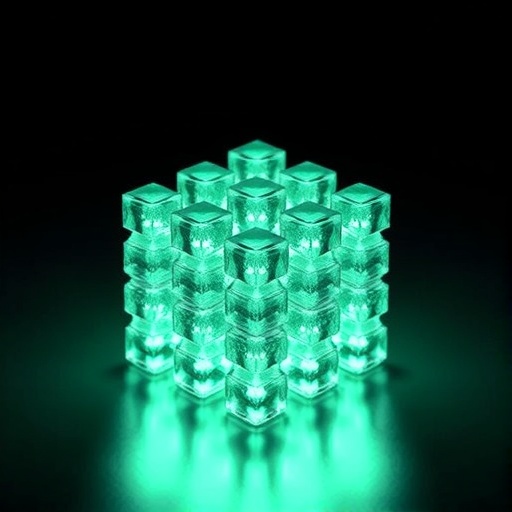In the pursuit of innovative energy storage solutions, researchers have made significant strides in enhancing the performance capabilities of supercapacitors. A remarkable advancement in this field has emerged from a study conducted by Zhou, Chen, and Wang, which introduces novel cube-like CoSe2/Fe7Se8 composites. These materials have been meticulously constructed using Prussian blue analogs, aiming to revolutionize the efficiency and effectiveness of supercapacitors.
Supercapacitors, known for their ability to rapidly charge and discharge energy, are increasingly being recognized for their potential applications in various fields, including electric vehicles, renewable energy systems, and electronic devices. However, the quest for higher energy density and better charge retention continues to challenge scientists and engineers. The introduction of CoSe2/Fe7Se8 composites represents a significant leap forward in addressing these challenges.
The synthesis of the CoSe2/Fe7Se8 composites is a meticulous process that combines various advanced methods to ensure optimal structural integrity and performance. The utilization of Prussian blue analogs is particularly noteworthy because of their unique properties that contribute to enhanced conductivity and stability when integrated into supercapacitor applications. These analogs serve as precursors that ultimately shape the nanostructure of the final composite material, providing a platform for superior electrochemical performance.
One of the defining characteristics of these new composites is their cube-like morphology, which is not just an aesthetic feature but plays a crucial role in performance enhancement. The unique geometric structure allows for increased surface area and active site availability, thereby facilitating more efficient ion transport during charge and discharge cycles. This structural optimization is essential for maximizing performance, particularly in terms of energy density and power density.
In laboratory tests, the CoSe2/Fe7Se8 composites demonstrated exceptional electrochemical properties, outperforming traditional supercapacitor materials. The calculated energy density reached new heights, confirming the effectiveness of the composite structure in facilitating energy storage. Furthermore, the cycling stability exhibited by these materials was notably impressive, indicating their potential for long-term applications without significant degradation in performance.
The development of such high-performance materials is timely, given the global push for sustainable energy solutions. As industries seek to integrate more renewable energy sources, the demand for efficient and reliable energy storage systems has never been higher. Supercapacitors, with their rapid charge and discharge capabilities, play a vital role in this transition, especially when coupled with advanced materials like CoSe2/Fe7Se8 composites.
The integration of these composites into supercapacitor systems is not without challenges. Researchers are continuously investigating the scaling of the synthesis process to maintain performance while optimizing production costs. The long-term goal is to transition from laboratory-scale successes to industrial-scale applications without compromising the desirable characteristics of the materials.
Testing in real-world applications presents another layer of complexity. While laboratory results are promising, further investigations are needed to ascertain the longevity and reliability of the composites under varying operational conditions. These studies will be crucial in determining the feasibility of deploying such materials in commercial supercapacitors.
Moreover, the researchers are exploring potential modifications to the composite structure. By experimenting with different compositions and structural designs, there is an opportunity to further enhance the electrochemical behavior of the supercapacitors. This iterative approach is foundational in materials science, where minor tweaks can lead to significant improvements in performance metrics.
Collaboration across interdisciplinary teams is also becoming increasingly important in advancing supercapacitor technology. The integration of material science, electronic engineering, and environmental science realms will propel innovations like the CoSe2/Fe7Se8 composites into the commercial sector more efficiently. It is through these collaborative efforts that more robust and sustainable energy solutions can be developed.
Looking forward, the implications of this research extend beyond supercapacitors alone. The properties of CoSe2/Fe7Se8 composites may have broader applications in other energy storage technologies, such as lithium-ion batteries, where performance improvements can substantially influence the efficiency and affordability of electric vehicles and portable electronics.
In conclusion, the synthesis and characterization of cube-like CoSe2/Fe7Se8 composites represent a notable advancement in the field of supercapacitors. As researchers continue to refine these materials and investigate their potentials, the future of energy storage is indeed bright. This development is not merely an academic achievement but a step towards more efficient and sustainable energy systems that could shape the future of technology and energy consumption worldwide.
The intersection of materials science and energy technology is producing exciting developments, and with studies like that of Zhou, Chen, and Wang, we can expect to see a new era of advanced supercapacitors that offer not just incremental improvements but revolutionary changes in how we store and use energy.
Subject of Research: Development of high-performance supercapacitor composites using Prussian blue analogs.
Article Title: The cube-like CoSe2/Fe7Se8 composites of high-performance supercapacitors prepared with Prussian blue analogs.
Article References: Zhou, T., Chen, C. & Wang, Z. The cube-like CoSe2/Fe7Se8 composites of high-performance supercapacitors prepared with Prussian blue analogs. Ionics (2025). https://doi.org/10.1007/s11581-025-06706-2
Image Credits: AI Generated
DOI: https://doi.org/10.1007/s11581-025-06706-2
Keywords: Supercapacitors, Energy storage, CoSe2/Fe7Se8 composites, Prussian blue analogs, Electrochemical performance, Sustainable energy solutions.




